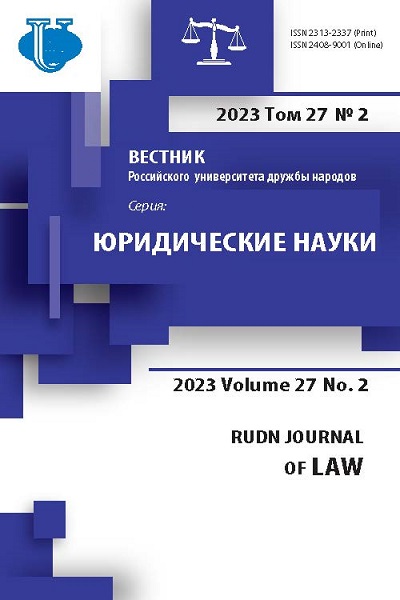The application of artificial intelligence in the civil proceedings of the People’s Republic of China: theoretical and legal analysis
- Authors: Rusakova E.P.1
-
Affiliations:
- RUDN University
- Issue: Vol 27, No 2 (2023)
- Pages: 468-480
- Section: PROCEDURAL LAW
- URL: https://journals.rudn.ru/law/article/view/35036
- DOI: https://doi.org/10.22363/2313-2337-2023-27-2-468-480
- EDN: https://elibrary.ru/DSOMQQ
- ID: 35036
Cite item
Full Text
Abstract
The subject of the research of this article is the social relations arising in the process of integrating artificial intelligence technologies into the judicial proceedings of the People’s Republic of China (PRC). The article discusses the legal framework governing this process, as well as the theoretical and legal analysis of the phenomenon of artificial intelligence in the new legal reality. Special attention is paid to the value and essential characteristics of artificial intelligence in justice, its types and components from the standpoint of the methodology of law. Moreover, the objectives, principles, scope and system of the use of artificial intelligence in legal proceedings, as well as measures of state support for this process are analyzed. The research shows that the process of introducing artificial intelligence into legal proceedings is complex and requires serious legal understanding of these technologies in the context of justice administration. The author draws conclusions concerning effectiveness and pragmatism of the process of integrating artificial intelligence into the judicial system of the People’s Republic of China. However, a fully automated process of justice in the courts of the People’s Republic of China can lead to extremely negative consequences for the judicial system, which may cause distrust to the judicial method of protecting rights and reduce society’s commitment to basic socialist values and customs.
Keywords
About the authors
Ekaterina P. Rusakova
RUDN University
Author for correspondence.
Email: rusakova-ep@rudn.ru
ORCID iD: 0000-0001-6488-0754
ResearcherId: L-5478-2017
Doctor of Legal Sciences, Associate Professor of the Department of Civil Law and Procedural Law and Private International Law, Law Institute
6 Miklukho-Maklaya str., Moscow, 117198, Russia FederationReferences
- Bashilov, B.I. & Berman, A.M. (2022) Procedural documents in the era of new technologies: how legal design has changed the legal world. Smart Innovation, Systems and Technologies. (288), 261-270. https://doi.org/10.1007/978-981-16-9808-8_28
- Ermakova, E.P. & Frolova, E.E. (2022) Using Artificial Intelligence in Dispute Resolution. Smart Innovation, Systems and Technologies. (254), 131-142. https://doi.org/10.1007/978-981-16-4621-8_11
- Frolova, E.E. (2020) Innovative tools and new financial institutions in the field of “green” financing. Eurasian Law Journal. 12(151), 33-37.
- Gronic, I.A. (2022) On some aspects of case management in electronic courts of Indonesia. Smart Innovation, Systems and Technologies. (288), 193-199. https://doi.org/10.1007/978-981-16-9808-8_21
- Han Kang. (2021) On the mode of blockchain deposit: a comparison between “third-party deposit” and “self-deposit”. Academic Exploration. (10), 47-54. (in Chinese).
- Kudryavtseva, E.V. (2021) Look from the past and present at the future of civil procedural legislation. Zakony Rossii: opyt, analiz, praktika. (9), 10-13. (in Russian).
- Qin, Han. (2021) Academic reflection on artificial intelligence judicial system. Northern Law. (03), 115-129. https://doi.org/10.13893/j.cnki.bffx.2021.03.010 (in China).
- 秦汉. (2021) 人工智能司法裁判系统的学理反思. 北方法学. (03), 115-129. https://doi.org/10.13893/j.cnki.bffx.2021.03.010
- Rusakova, E.P. & Frolova, E.E. (2022) Procedural Standards for Civil Proceedings in China’s Internet Courts. Smart Innovation, Systems and Technologies. (288), 187-192. https://doi.org/10.1007/978-981-16-9808-8_20
- Shen, Zhai. (2019) Functions and limitations of judicial artificial intelligence from the point of view of case justice. Journal of University of Jinan (Science and Technology). (4), 115-129. (in China).
- Shuai, Yina. (2020) The practical possibility and essential limitation of artificial intelligence assisted judicial adjudication. East China university of political science and law. (4), 101-110. (in China).
- Solovyev, A.A. (2022) Digital technologies in legal proceedings: foreign experience. Moscow District Commercial Court Bulletin. (3), 71-76. https://doi.org/10.46279/ASMO. 2022.92.43.004 (in Russian).
- Solovyev, A.A. (2021) International approaches towards the doctrine of legal certainty in court procedure. Law and State: The theory and practice. 8(200), 127-131. https://doi.org/10.47643/1815-1337_2021_8_127 (in Russian).
- Vlasenko, N.A. (2021) Anti-innovation trends in modern legal science. Juridical techniques. (15), 48-57. (in Russian).
- Wei, Bin. (2021) Juridical Reflectionon Smart Justiceand the Responses. Politics and Law. (8), 111-125. (in China).
- Xi, Zheng (2020) Application and Regulation of Artificial Intelligence in Trials. Peking University Law Journal. 32(3), 674-696. (in Chinese).
- Yastrebov, O.A. (2021) Artificial intelligence in the legal space: discussion and development prospects. In: Blazheev, V.V. & Egorova, M.A. (eds.). Transformation of models of legal regulation of objects of innovation infrastructure in modern law: Russian and foreign experience: monograph. Moscow, Prospekt Publ. pp. 278-309. (in Russian).
- Zakharkina, A. & Kuznetsova, O. (2021) Foreign civil doctrine of smart contracts. In: SHS Web of Conferences: 14th Session of Euro-Asian Law Congress “The value of law” 2021, Ekaterinburg. Vol. 134. Ekaterinburg, EDP Sciences Publ. pp. 00016. https://doi.org/10.1051/shsconf/202213400016
- Zhao, Yang (2021) Judicial trust and its construction in the era of artificial intelligence. Journal of East China University of Political Science and Law. (4), 73-82.
Supplementary files















